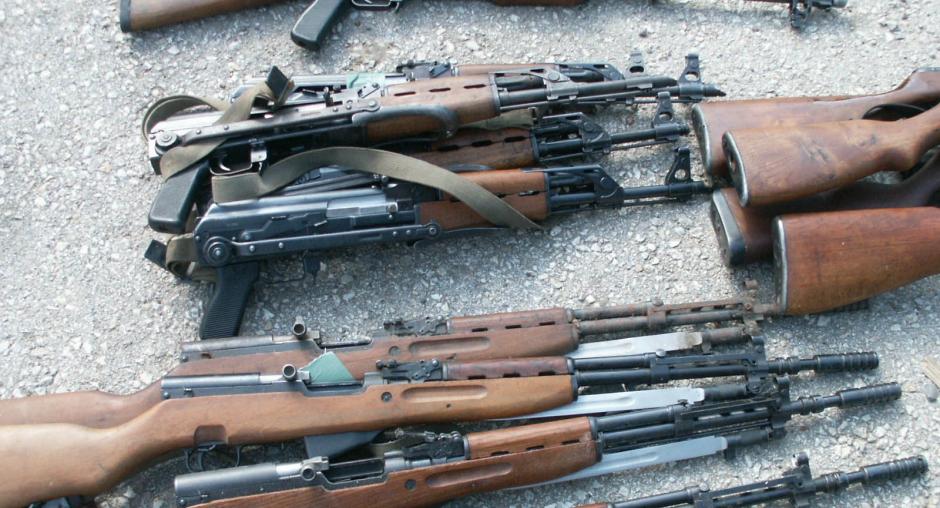Newsroom
Central Asia workshop introduces OSCE Handbook on Small Arms and Light Weapons
ASHGABAD 18 May 2004

(OSCE)Small arms and light weapons collected in Vlasenica, Bosnia
and Herzegovina, 31 May 2002. (OSCE) Photo details
ASHGABAD, 18 May 2004 - A regional workshop on the OSCE's recently released "Handbook of Best Practices on Small Arms and Light Weapons" was held in the Turkmen capital on 17 and 18 May.
Bringing together officials from Kazakhstan, Kyrgyzstan, Tajikistan, Turkmenistan and Uzbekistan, it was designed to familiarise these Central Asian States with the recommendations of the Handbook and to facilitate the implementation of the Document.
"This is a unique manual - a first among international and regional institutions - which amounts to a comprehensive set of "best practice guides" on reducing the threat of small arms," said Ambassador Paraschiva Badescu, Head of the OSCE Centre in Ashgabad.
The Ambassador also recalled that while weapons of mass destruction figure frequently in the news, the reality is that many more people are killed or maimed by weapons with less destructive power.
"Small arms - anything from revolvers to powerful assault rifles - are used, often by child soldiers, to terrorize and slaughter thousands of non-combatants each year," she said. "Light weapons are available on a well-organized black market to any groups or forces with the ability to pay. Trafficking in small arms is an especially significant threat today because it underpins both terrorism and organized crime."
Participants in the workshop shared their experiences on areas of common concern regarding the prevention of illicit trafficking in small arms and light weapons.
International experts representing OSCE countries directly involved in developing the Handbook spoke about areas such as manufacture, marking and record keeping, stockpile management and identification of surpluses, as well as the destruction and decommissioning processes.
The Handbook is based on the OSCE Document on Small Arms and Light Weapons which was adopted by the OSCE Forum for Security Co-operation on 24 November 2000 and on practical experiences since then.
The event was organized by the OSCE Centre in Ashgabad and the OSCE Secretariat's Conflict Prevention Centre in co-operation with the Ministry of Foreign Affairs of Turkmenistan.
Bringing together officials from Kazakhstan, Kyrgyzstan, Tajikistan, Turkmenistan and Uzbekistan, it was designed to familiarise these Central Asian States with the recommendations of the Handbook and to facilitate the implementation of the Document.
"This is a unique manual - a first among international and regional institutions - which amounts to a comprehensive set of "best practice guides" on reducing the threat of small arms," said Ambassador Paraschiva Badescu, Head of the OSCE Centre in Ashgabad.
The Ambassador also recalled that while weapons of mass destruction figure frequently in the news, the reality is that many more people are killed or maimed by weapons with less destructive power.
"Small arms - anything from revolvers to powerful assault rifles - are used, often by child soldiers, to terrorize and slaughter thousands of non-combatants each year," she said. "Light weapons are available on a well-organized black market to any groups or forces with the ability to pay. Trafficking in small arms is an especially significant threat today because it underpins both terrorism and organized crime."
Participants in the workshop shared their experiences on areas of common concern regarding the prevention of illicit trafficking in small arms and light weapons.
International experts representing OSCE countries directly involved in developing the Handbook spoke about areas such as manufacture, marking and record keeping, stockpile management and identification of surpluses, as well as the destruction and decommissioning processes.
The Handbook is based on the OSCE Document on Small Arms and Light Weapons which was adopted by the OSCE Forum for Security Co-operation on 24 November 2000 and on practical experiences since then.
The event was organized by the OSCE Centre in Ashgabad and the OSCE Secretariat's Conflict Prevention Centre in co-operation with the Ministry of Foreign Affairs of Turkmenistan.
